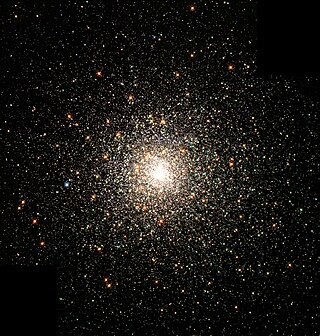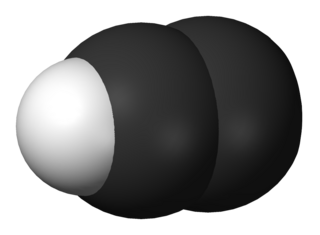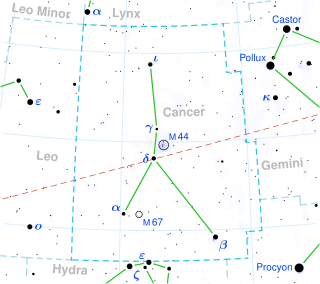Related Research Articles

In 1944, Walter Baade categorized groups of stars within the Milky Way into stellar populations. In the abstract of the article by Baade, he recognizes that Jan Oort originally conceived this type of classification in 1926.
GY Andromedae is an α2 Canum Venaticorum type variable star in the northern constellation Andromeda. Its brightness fluctuates in visual magnitude between 6.27m and 6.41m, making it a challenge to view with the naked eye even in good seeing conditions. The magnetic activity on this star shows an unusually long period of variability, cycling about once every 23 years. Based upon parallax measurements, this star is located at a distance of about 460 light-years from the Earth.
A carbon star is typically an asymptotic giant branch star, a luminous red giant, whose atmosphere contains more carbon than oxygen. The two elements combine in the upper layers of the star, forming carbon monoxide, which consumes most of the oxygen in the atmosphere, leaving carbon atoms free to form other carbon compounds, giving the star a "sooty" atmosphere and a strikingly ruby red appearance. There are also some dwarf and supergiant carbon stars, with the more common giant stars sometimes being called classical carbon stars to distinguish them.

In astronomy, metallicity is the abundance of elements present in an object that are heavier than hydrogen and helium. Most of the normal currently detectable matter in the universe is either hydrogen or helium, and astronomers use the word "metals" as a convenient short term for "all elements except hydrogen and helium". This word-use is distinct from the conventional chemical or physical definition of a metal as an electrically conducting solid. Stars and nebulae with relatively high abundances of heavier elements are called "metal-rich" in astrophysical terms, even though many of those elements are nonmetals in chemistry.
HD 37124 is a star in the equatorial constellation of Taurus, positioned about a half degree to the SSW of the bright star Zeta Tauri. The apparent visual magnitude of this star is 7.68, which is too dim to be visible to the naked eye. It is located at a distance of 103 light years from the Sun based on parallax, but is drifting closer with a radial velocity of −23 km/s. Three extrasolar planets have been found to orbit the star.

15 Cancri is an α2 CVn-type variable star in the zodiac constellation of Cancer, located around 980 light years away. It has the variable star designation BM Cancri ; 15 Cancri is the Flamsteed designation. This system is visible to the naked eye as a faint, white-hued star with an apparent visual magnitude of about 5.6. It is moving away from the Earth with a heliocentric radial velocity of 25 km/s.
BPS CS22892-0052 is an old population II star located at a distance of 4.7 kiloparsecs in the Milky Way's galactic halo. It belongs to a class of ultra-metal-poor stars, specifically the very rare subclass of neutron-capture (r-process) enhanced stars. It was discovered by Tim C. Beers and collaborators with the Curtis Schmidt telescope at the Cerro Tololo Inter-American Observatory in Chile. Extended high-resolution spectroscopic observations since around 1995 allowed observers to determine the abundances of 53 chemical elements in this star, as of December 2005 only second in number to the Sun.

The ethynyl radical (systematically named λ3-ethyne and hydridodicarbon(C—C)) is an organic compound with the chemical formula C≡CH (also written [CCH] or C
2H). It is a simple molecule that does not occur naturally on Earth but is abundant in the interstellar medium. It was first observed by electron spin resonance isolated in a solid argon matrix at liquid helium temperatures in 1963 by Cochran and coworkers at the Johns Hopkins Applied Physics Laboratory. It was first observed in the gas phase by Tucker and coworkers in November 1973 toward the Orion Nebula, using the NRAO 11-meter radio telescope. It has since been detected in a large variety of interstellar environments, including dense molecular clouds, bok globules, star forming regions, the shells around carbon-rich evolved stars, and even in other galaxies.
HD 172044 is a triple star system in the northern constellation of Lyra. It has a blue-white hue and is visible to the naked eye with an apparent visual magnitude of 5.41. The distance to the primary component is approximately 535 light years based on parallax. It is drifting closer with a radial velocity of −32.5 km/s, and is predicted to come as near as 77.3 light-years to the Sun some 4.5 million years from now.
HD 122563 is an extremely metal-poor red giant star, and the brightest metal-poor star in the sky. Its low heavy element content was first recognized by spectroscopic analysis in 1963. For more than twenty years it was the most metal-poor star known, being more metal-poor than any known globular cluster, and it is the most accessible example of an extreme population II or Halo star.

HD 269810 is a blue giant star in the Large Magellanic Cloud. It is one of the most massive and most luminous stars known, and one of only a handful of stars with the spectral type O2.

ET Andromedae is a binary star system star in the northern constellation of Andromeda. It has an apparent visual magnitude of 6.48, placing it at the nominal limit for visibility with the naked eye. The distance to this system can be estimated from its annual parallax shift of 5.42 mas, which yields a value of 602 light years.
An Am star or metallic-line star is a type of chemically peculiar star of spectral type A whose spectrum has strong and often variable absorption lines of metals such as zinc, strontium, zirconium, and barium, and deficiencies of others, such as calcium and scandium. The original definition of an Am star was one in which the star shows "an apparent surface underabundance of Ca and/or an apparent overabundance of the Fe group and heavier elements".

Imidogen is an inorganic compound with the chemical formula NH. Like other simple radicals, it is highly reactive and consequently short-lived except as a dilute gas. Its behavior depends on its spin multiplicity.

HD 165634 is a star in the southern constellation of Sagittarius. It has a yellow hue and is faintly visible to the naked eye with apparent visual magnitude of 4.56. The star is located at a distance of approximately 339 light years from the Sun based on parallax, but is drifting closer with a radial velocity of −5 km/s. It has an absolute magnitude of −0.53.

X Cancri is a variable star in the northern constellation of Cancer. It has a red hue and is visible to the naked eye at its brightest. The distance to this object is approximately 1,860 light years based on parallax measurements, but is drifting closer with a radial velocity of −5 km/s. It lies very close to the ecliptic and so is subject to lunar occultations.

17 Comae Berenices is a multiple star system in the northern constellation of Coma Berenices. The brighter component, 17 Com A, is a naked eye star with an apparent visual magnitude of 5.2. It has a faint companion of magnitude 6.6, 17 Com B, positioned at an angular separation of 146.4″ along a position angle of 251°, as of 2018. They are located at a distance of approximately 240 light years from the Sun based on parallax measurements.
KS Persei is a binary system in the equatorial constellation of Perseus. It is sometimes known as Bidelman's Star, named after William P. Bidelman. The star is invisible to the naked eye with a mean apparent visual magnitude of 7.70. As of 2018, the structure and evolutionary history of this system remain uncertain, although some form of mass transfer is likely to have occurred to explain the observed properties.
James Wellington Truran Jr. was an American physicist, known for his research in nuclear astrophysics.
References
- ↑ Sneden, Christopher (1973), "The nitrogen abundance of the very metal-poor star HD 122563", Astrophysical Journal, 184: 839–849, Bibcode:1973ApJ...184..839S, doi:10.1086/152374